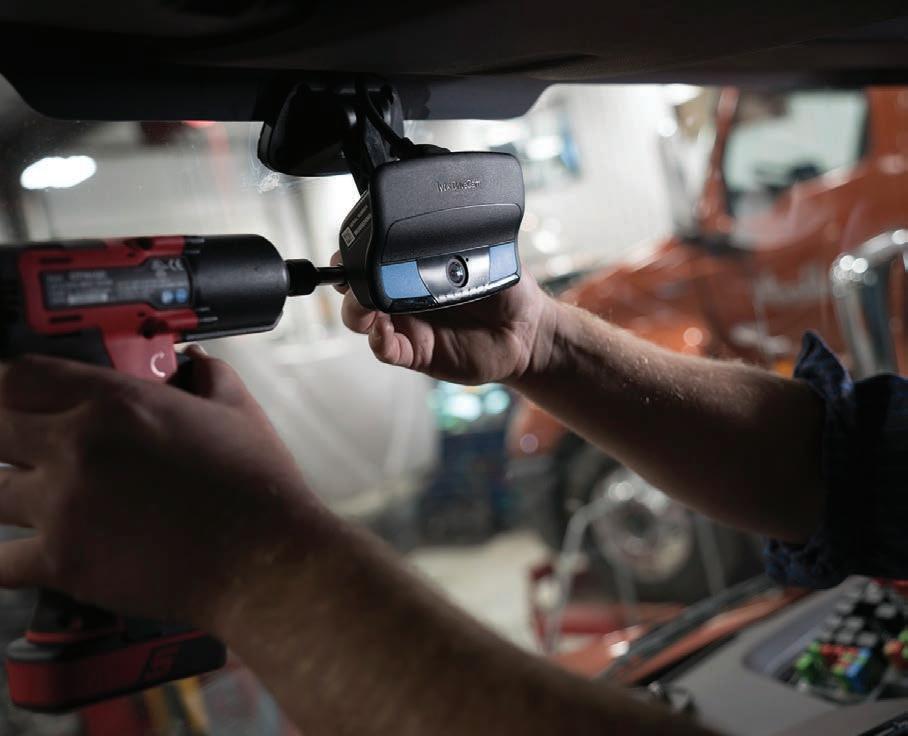
6 minute read
On Business




Cost control

How fl eets use technology and safety initiatives to reduce insurance costs
By Denise L. Rondini


One of the greatest expenses of operating a trucking company is insurance. The company’s risks and responsibilities are reflected in the steep cost of insurance premiums — which are directly impacted by rising costs of settlement and litigation. While advances in safety technology ought to keep rates down, the truth is that managing key cost trends requires constant effort. The good news is there are steps fleets can take to lower their insurance premiums and make their fleets safer.
Obsession with safety
Insurance premiums cost fleets between 7.5 cents and 8.8 cents a mile, or 4% of their total average margin costs, according to the American Transportation Research Institute. The reality is those costs can be even higher because self insuring and high deductibles can give the appearance that insurance costs are lower than they actually are. Michael Nischan, vice president of transportation and logistic risk control at EPIC Insurance Brokers & Consultants, says that “fleets need to be obsessed with safety.” Part of that obsession should include an investment in safety- related technologies coupled with operational practices that demonstrate a commitment to safety throughout the fleet. This includes adhering to all driver qualification standards, drug and alcohol testing standards, hours of service regulations, cargo securement standards and complying with Federal Motor Carrier Safety Administration safety regulations. Insurance companies consider a variety of factors when determining whether to insure a fleet and what plan premiums should be. Terri Lutz, vice president of risk management at Transervice Logistics, says some of the questions that have to be answered include size of the fleet, types of vehicles in the fleet, radius of operation, driver selection process and products being hauled. However, when promulgating premiums, one of the biggest factors is prior loss experience. In other words, how many accidents and therefore claims has the fleet experienced in the past three years?
Technology upgrades
Bad prior loss experience does not have to define a fleet forever. A wide range of technologies on the market today can help reduce the number or severity of accidents, and can demonstrate to an insurance underwriter that drivers are operating safely and fleet managers are working hard to provide coaching in instances where problems occur. These include cameras, lane-departure warning systems and collision mitigation systems, all of which serve to
lessen the chance of a vehicle being involved in an accident.
“Fleets with poor loss experience can over time see savings because of technology. If you have a lot of side sweeps or rear-end collisions, there is technology that can mitigate those losses. Over time you won’t have those claims anymore and so you become a lower risk. This can lead to the fleet enjoying some savings down the road, but it will not happen right away,” Lutz explains. In essence, a fleet has to take action to improve its loss experience. “Your past loss experience is indicative of your future potential loss if you don’t change anything. Over time if a fleet makes these technological investments then they won’t have those three to four rear-end accidents and they won’t have those five to six side-swipe events.” Nischan encourages fleets to review their SMS reports each month to look for things like the type of moving violations the fleet has been cited for, types of maintenance issues found during roadside inspections, and percent of out-of-service violations for drivers and trucks.
“Figure out what the trends are and then address them by applying your policies, procedures, training and disciplinary actions to change behavior,” Nischan says.
Get smart with telematics
Data from telematics systems, especially those that incorporate cameras, allow fleet managers to see not only what is going on in the cab but also on the road. Cameras give context to the data, which can help with behavior management.
According to statistics from Lytx, makers of an onboard camera, DriveCam, fleets that have camera-equipped trucks can see claim cost reductions of up to 80%, plus a 50% reduction in collision frequency. This is significant given that the Federal Motor Carrier Safety Administration found that the average cost of a large truck crash with a fatality is $3.6 million, and a crash with injuries costs
Installing on-board video cameras can help lower insurance costs.
on average $200,000. However, in the past five to six years, Nischan says there has been a rise in “nuclear verdicts” following truck accidents. “It used to be that we were seeing verdicts of $750,000, maybe up to $5 million, but in the past few years we have seen staggering numbers — $10 million, $20 million, $50 million, even $90 million verdicts.”
Nischan says cameras, lane-departure warning systems, collision avoidance systems and other safety related technologies are not a guarantee of a lower premium but are one piece of a fleet’s overall committment to safety and dedication to a safety culture.
Focus on accountability, communication
Technology alone is not enough, he says. “The company needs to have someone who is accountable for the overall risk management, compliance and safety process. You need to have a transportation management program and you need to make sure that all levels of the organization are educated [about safety],” he says.
When rolling out safety technology in general, and driver-facing cameras in particular, Nischan says a fleet should not just announce that it is installing cameras and tell drivers they have to deal with it. Rather they need to make sure drivers understand the purpose of the cameras and that the fleet allows coaching and feedback within the first 60 days before taking any punitive measures. “When you install the camera, give feedback and provide coaching and ongoing training. This will change the company’s safety culture as well as driver behavior,” he says.
“During preliminary rollout your culture will change, driver behavior will change, drivers will become safer and therefore less likely than they were at the beginning of that trial period to be involved in a collision.”
Both Nischan and Lutz were clear that a safety culture starts at the top. “You need to have buy-in at the uppermost levels of management,” Lutz says. “And then it must flow all the way down the organization. In addition, you have to be willing to expend resources, time and money on your safety initiatives.” Insurance companies define trucking as a very difficult class of business to insure, but by investing in technology and having safety programs and with best practices in place, the fleet can be an excellent risk and should be able to keep its insurance premiums to a reasonable level.
Michael Nischan, vice president of transportation and logistic risk control at EPIC Insurance Brokers & Consultants





